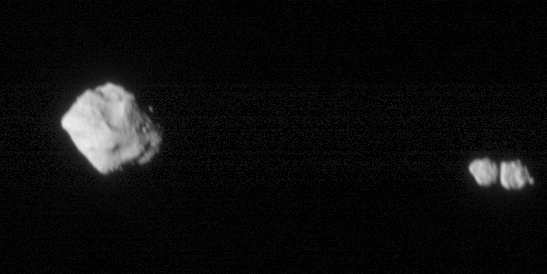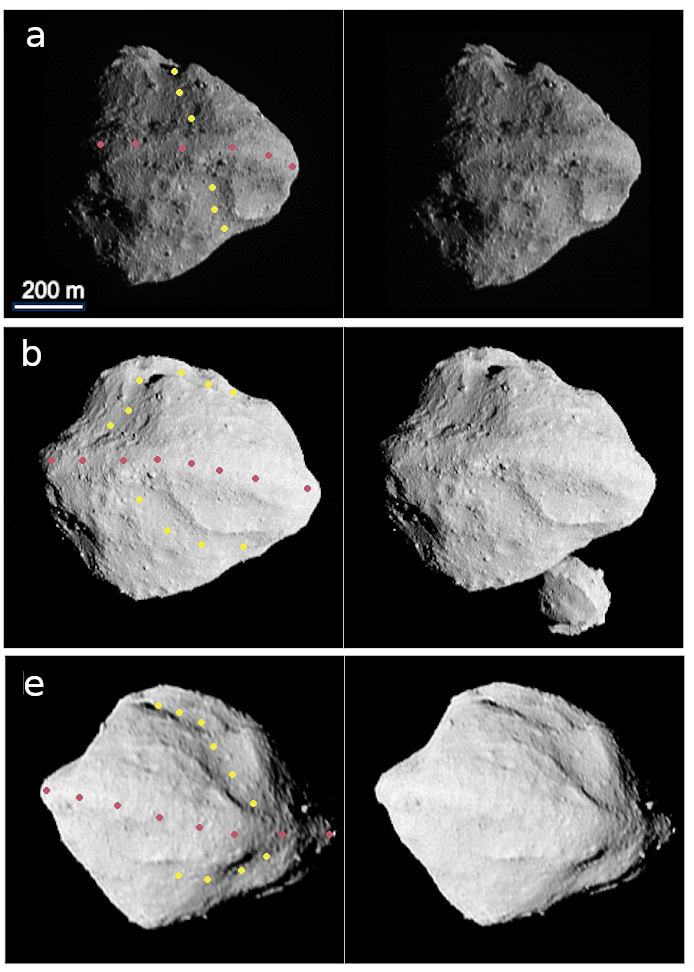An overview of NASA Lucy misson’s encounter with the main belt asteroid Dinkinesh
- 1SwRI, Depart of Space Sciences, Boulder, United States of America (hal@boulder.swri.edu)
- 2NASA/Goddard Space Flight Center, Greenbelt, MD, United States
- *A full list of authors appears at the end of the abstract
On November 1, 2023, Lucy passed within 430 km of the smallest Main Belt asteroid yet to be encountered by a spacecraft, (152830) Dinkinesh. This target was a late addition to the Lucy mission [1] and was intended primarly as an in-flight test of Lucy’s autonomous range-finding and tracking system [2]. Dinkinesh orbits the Sun near the inner edge of the Main Asteroid Belt with a heliocentric semimajor axis of 2.19 AU. Its ground-based reflectance spectrum shows a silicate band at 0.95 µm best fit as an Sq-type [3,4].
Lucy approached Dinkinesh at a solar phase angle of 120°; at close approach the phase dropped rapidly, going through near-zero and then increased to an out-bound phase of 60°. The relative velocity of Lucy and Dinkinesh was 4.5 km/s.
All of the instruments aboard Lucy [2] successfully observed Dinkinesh during the encounter. Here we present the results from L'LORRI and L'Ralph. L'LORRI, which stands for Lucy’s LOng Range Reconnaissance Imager, is a panchromatic (350 — 850 nm) imager with a 20.8 cm, f/13 telescope feeding a 1024 × 1024 pixel CCD focal plane [5]. L'LORRI revealed Dinkinesh, which has an effective diameter of only ~720 m, to be an unexpectedly complex system. Of particular note is the discovery of the first confirmed contact binary asteroid satellite, now named (152830) Dinkinesh I Selam. Figure 1 shows a L’LORRI image of the Dininesh system taken about 6 minutes after close approach when the spacecraft was ~1600 km from the primary. It clearly shows that Selam consists of two near-equal sized lobes of ∼200 m each. It orbits Dinkinesh at a distance of roughly 3km.

Figure 1
Figure 2 shows three cross-eyed stereo images of Dinkinesh taken on approach, near close approach, and on departure, respectively. Dinkinesh has two major geological features: a longitudinal trough and an equatorial ridge (the yellow and rose colored dots, respectively). The ridge overlays the trough implying that it is the younger of the two structures. However, there is as yet no information to better constrain their relative ages, and thus they could potentially have formed in the same event. Indeed, Dinkinesh’s ridge and trough are likely the result of mass failure and the reaccretion of material, and may both be linked to the formation of Selam.

Figure 2
The L’Ralph instrument on the Lucy mission consists of two focal planes sharing a common optical path: MVIC, a multi-spectral visible/NIR camera and LEISA, a shortwave infrared hyperspectral imager [6]. MVIC obtains images in 5 color bands with band-centers ranging from 430 nm to 850 nm, while LEISA covers the spectral range from 0.9 to 3.95 mm. Observations of the Dinkinesh system were taken near closest approach. As a result, the phase angle was changing rapidly, and the reflectance had to be corrected accordingly. It was also found that both MVIC and LEISA data were consistent with that expected for an S/Sq-type asteroid such as Dinkinesh (e.g. see Figure 3 for a comparison to 433 Eros[7]). The spectra of Dinkinesh and Selam were identical to within measurement uncertainties.
Figure 3
Acknowledgements: The Lucy mission is funded through the NASA Discovery program on contract No. NNM16AA08C. The authors thank the entire Lucy mission team for their hard work and dedication.
References: [1] Levison H. et al. (2021), PSJ 2(5), 171. [2] Olkin C. et al. (2021) PSJ 2(5), 172. [3] Bolin B. (2023) Icarus 400, 115562. [4] de León J. et al. (2023) A&A, 672, A174. [5] Weaver H. et al. (2023) SSRv, 219, 82. [6] Reuter, D. et al. (2023), Space Science Rev. 219, 69. [7] Binzel, R. et al. (2004), Icarus 170, 259-294
Harold Levison, Simone Marchi, Keith Noll, John Spencer, Thomas Statler, James Bell III, Edward Bierhaus, Richard Binzel, William Bottke, Daniel Britt, Michael Brown, Marc Buie, Philip Christensen, Neil Dello Russo, Joshua Emery, William Grundy, Matthias Hahn, Victoria Hamilton, Carly Howett, Hannah Kaplan, Katherine Kretke, Tod Lauer, Claudia Manzoni, Raphael Marschall, Audrey Martin, Brian May, Stefano Mottola, Catherine Olkin, Martin Pätzold, Joel Parker, Simon Porter, Frank Preusker, Silvia Protopapa, Dennis Reuter, Stuart Robbins, Julien Salmon, Amy Simon, S. Alan Stern, Jessica Sunshine, Ian Wong, Harold Weaver, Coralie Adam, Shanti Ancheta, John Andrews, Saadat Anwar, Olivier Barnouin, Matthew Beasley, Kevin Berry, Emma Birath, Bryce Bolin, Mark Booco, Rich Burns, Pam Campbell, Russell Carpenter, Katherine Crombie, Mark Effertz, Emily Eifert, Caroline Ellis, Preston Faiks, Joel Fischetti, Paul Fleming, Kristen Francis, Ray Franco, Sandy Freund, Claire Gallagher, Jeroen Geeraert, Caden Gobat, Donovan Gorgas, Chris Granat, Sheila Gray, Patrick Haas, Ann Harch, Katie Hegedus, Chris Isabelle, Bill Jackson, Taylor Jacob, Sherry Jennings, David Kaufmann, Brian Keeney, Thomas Kennedy, Karl Lauffer,Erik Lessac-Chenen, Rob Leonard, Andrew Levine, Allen Lunsford, Tim Martin, Jim McAdams, Greg Mehall, Trevor Merkley, Graham Miller, Matthew Montanaro, Anna Montgomery, Graham Murphy, Maxwell Myers, Derek Nelson, Adriana Ocampo, Ryan Olds, John Pelgrift, Trevor Perkins, Jon Pineau, Devin Poland, Vaishnavi Ramanan, Debi Rose, Eric Sahr, Owen Short, Ishita Solanki, Dale Stanbridge, Brian Sutter, Zachary Talpas, Howard Taylor, Bo Treiu, Nate Vermeer, Michael Vincent , Mike Wallace, Gerald Weigle, Daniel Wibben, Zach Wiens, John Wilson, and Yifan Zhao
How to cite: Levison, H. and Noll, K. and the Lucy Team: An overview of NASA Lucy misson’s encounter with the main belt asteroid Dinkinesh, Europlanet Science Congress 2024, Berlin, Germany, 8–13 Sep 2024, EPSC2024-561, https://doi.org/10.5194/epsc2024-561, 2024.